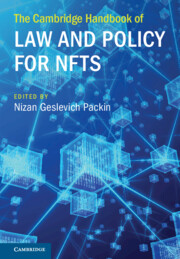Book contents
- The Cambridge Handbook of Law and Policy for NFTs
- The Cambridge Handbook of Law and Policy for NFTs
- Copyright page
- Dedication
- Contents
- Figures
- Tables
- Contributors
- Acknowledgments
- Part I Introduction and Background
- Part II Financial Regulation and Investor Protection
- Part III Capital Markets, Community, and Marketing
- Part IV Intellectual Property and Ownership Rights
- 11 NFTs and Copyright Law
- 12 Unauthorized Minting and NFTs
- 13 Visual Art, Galleries, Collectibles, and NFTs
- 14 NFTs, Property Rights, and Realty
- Part V Data Protection, Privacy, Cybersecurity, and NFTs
- Part VI Other Legal Issues with NFTs
- Part VII Conclusions and Future Directions
- Index
14 - NFTs, Property Rights, and Realty
from Part IV - Intellectual Property and Ownership Rights
Published online by Cambridge University Press: 02 November 2024
- The Cambridge Handbook of Law and Policy for NFTs
- The Cambridge Handbook of Law and Policy for NFTs
- Copyright page
- Dedication
- Contents
- Figures
- Tables
- Contributors
- Acknowledgments
- Part I Introduction and Background
- Part II Financial Regulation and Investor Protection
- Part III Capital Markets, Community, and Marketing
- Part IV Intellectual Property and Ownership Rights
- 11 NFTs and Copyright Law
- 12 Unauthorized Minting and NFTs
- 13 Visual Art, Galleries, Collectibles, and NFTs
- 14 NFTs, Property Rights, and Realty
- Part V Data Protection, Privacy, Cybersecurity, and NFTs
- Part VI Other Legal Issues with NFTs
- Part VII Conclusions and Future Directions
- Index
Summary
For the past decade, blockchain, along with the recent ascent of non-fungible tokens (NFTs), have been hailed as revolutionary tools with the power to reshape the global economy, particularly in the context of property rights. In this chapter, drawn in part from the authors’ earlier work, the use of blockchains and NFTs in real property transactions is questioned by interrogating how the existing technologies work against the backdrop of the realities of real property transfers. Moving beyond the hype, the authors explain that a blockchain system would provide few if any benefits to the system of real estate transactions. Yet they think there is indeed a potential use case for blockchains and crypto technology when it comes to property rights. But, it is not in the world of real property – which our existing system has largely shown itself to be sufficient – but rather for intangible property. American law developed to deal with tangible assets, whether personal or real, owing to their historical prominence as primary wealth. But tracking and transferring rights in intangible property has always been underdeveloped. It is here, so we argue, that blockchain technology and NFTs might have the highest utility.
- Type
- Chapter
- Information
- The Cambridge Handbook of Law and Policy for NFTs , pp. 275 - 296Publisher: Cambridge University PressPrint publication year: 2024

